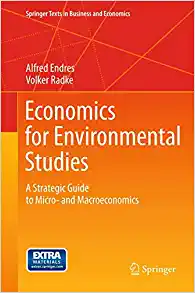Question
1:What are the estimated economic costs of global warming? Can we trust these estimates at higher average temperature increases? Why/why not? HOW MUCH FOR A
1:What are the estimated economic costs of global warming? Can we trust these estimates at higher average temperature increases? Why/why not?
HOW MUCH FOR A DEGREE OF WARMING? Compare the average climates in Stockholm, Singapore, and San Francisco. Stockholm may be a more pleasant place with a degree or two extra. Incidentally, that's precisely what Swedish scientist Svante Arrhenius, of greenhouse effect fame, suggested we may want to do deliberately: burn more coal "to enjoy ages with more equable and better climates, especially with regards to the colder regions of the earth." In Arrhenius's defense, he said so in 1908, after he had identified the greenhouse effect, but long before it became clear that there are significant costs to pumping carbon dioxide into the atmosphere. In the end, the costs of small temperature changes are, for the most part, the sum of the costs of changing what we've gotten used to. And it's not just that Swedes already own winter jackets and Singaporeans air conditioners. It's massive investments and industrial infrastructures, built around current climatesand current sea levelsthat make temperature increases costly. And once again, it isn't temperatures themselves that matter as much as what these rising temperatures entail. One such effect is rising sea levels. Then there are storm surges on topby then stronger and more frequent precisely because of climate change. And all that's the perfectly "normal," average effect of sea-level rise baked into where we are already heading. None of this is yet taking into account fat tails or other catastrophic scenarios. When models incorporate the latest science and quantify ever more of the damages likely to occur because of climate change, the estimated costs of carbon pollution go up. DICE & Co are perennially playing catch-up with the latest science. In 2010, the central U.S. government's 3 estimate of the social costs of one ton of carbon dioxide emitted in 2015 was around $25. The 2013 iteration increased it to around $40. None of this is meant to decry the modeling efforts. Quite the opposite. Getting things right is incredibly difficult. If anything, it is a call to invest in economic modelingin a big way. Nordhaus's DICE model, as well as its main competitors, FUND and PAGE, were all started by one person, and have been painstakingly maintained, patched, and modified over years and decades by a small group of dedicated economists. Meanwhile, when big business tries to analyze what toothpaste flavor to sell where, it uses massive quantities of geo-spatial, customer-level data, analyzed by dozens of dedicated statisticians and programmers. We certainly shouldn't scrap economic climate models for their inadequacy. If anything we should be supercharging them: IBM-ifying their operation. There's much more at stake here than with selling toothpaste. Yet Colgate and Procter & Gamble are competing with the help of massive data operations, while DICE can run on your home computer. More manpower and data would at least help the models incorporate the latest available information in real time. Even if we did all of that, though, there would still be one major problem: How should we quantify the damages caused by potentially catastrophic climate change? More data won't necessarily help us make inroads on that question. DICE & Co mostly look to the past for guidance. Hundreds of scientific studies try to quantify the impacts of global warming on anything from sea-level rise to crop yields to tropical storms to war. The task then is to translate those impacts into dollars and cents. We quickly run into two problems. For one, only a small part of known damages can be quantified. Lots are missing. The list of currently unquantified andat least in partunquantifiable damages spans everything from known respiratory illnesses from increased ozone pollution due to warmer surface temperatures to the effects of ocean acidification. Moreover, the only parts we can truly quantify are in a relatively narrow, low-temperature range: changes of fractions of a degree, maybe 1C (1.8F), or maybe 2C (3.6F) of global average warming. How can we estimate what happens at 5, 4, or even 3C (9, 7.2, or 5.4F)? Extrapolate, extrapolate, extrapolate. That's at least what current models do. Take what happens at 1 or 2C and scale it up. We know that, because of tipping points and other possibly nasty surprises, we can't just look at things linearly. No one seriously proposes that. Instead, DICE mostly relies on something close to quadratic extrapolations: If 1C causes $10 worth of damages, then 2C doesn't cause $20that's linearbut $40. More specifically, Nordhaus estimates that warming of 1C costs less than 0.5 percent of global GDP, 2C costs around 1 percent, 4C costs around 4 percent. Things take off after that, but even 6C stays below 10 percent. Mind you, that's a big absolute number: 10 percent of total, global economic output today would be around $7 trillion. If they were to materialize, by the time these 6C (11F) changes were to hit a century or more from now, the fraction of damages would be multiplied by a large growth factor. But how can we be certain that it's the right number? We can't. Once we extrapolate damage estimates as far out as 6C (11F), it all becomes guesswork. Using a quadratic function is a convenient shortcut, but it's not much more than that. Lots of other extrapolations would fit the observed damages on the lower end of the scale but would yield wildly different results on the upper end.
Step by Step Solution
There are 3 Steps involved in it
Step: 1

Get Instant Access to Expert-Tailored Solutions
See step-by-step solutions with expert insights and AI powered tools for academic success
Step: 2

Step: 3

Ace Your Homework with AI
Get the answers you need in no time with our AI-driven, step-by-step assistance
Get Started


